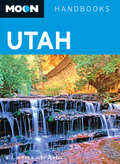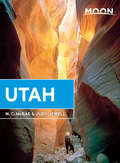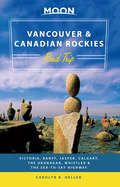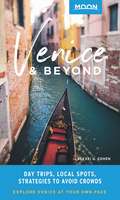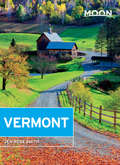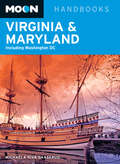- Table View
- List View
Moon Utah: 2013
by Judy Jewell Bill McraeSeasoned travel writers W. C. McRae and Judy Jewell share the best ways to experience all that the Beehive State has to offer, from sprawling, urban Salt Lake City to serene, mystical Arches National Park. The authors include great trip strategies that utilize Utah's amazing outdoor attractions and unique history, such as Standing High: The Best Vistas and The Old West Tour. Packed with information on dining, transportation, and accommodations, this handbook has lots of options for a range of travel budgets. Including expert advice on the state's best brewpubs, first-rate ski and snowboard resorts, and amazing national parks, Moon Utah gives travelers the tools they need to create a more personal and memorable experience.
Moon Utah: 2015
by W. C. Mcrae Judy JewellSeasoned travel writers W. C. McRae and Judy Jewell share the best ways to experience all that the Beehive State has to offer, from sprawling, urban Salt Lake City to serene, mystical Arches National Park. The authors include great trip strategies that utilize Utah's amazing outdoor attractions and unique history, such as Standing High: The Best Vistas and The Old West Tour. Packed with information on dining, transportation, and accommodations, this handbook has lots of options for a range of travel budgets. Including expert advice on the state's best brewpubs, first-rate ski and snowboard resorts, and amazing national parks, Moon Utah gives travelers the tools they need to create a more personal and memorable experience.
Moon Utah: Strategic Itineraries, Year-Round Recreation, Avoid the Crowds (Moon U.S. Travel Guide)
by Moon Travel Guides Maya SilverFrom remote deserts and arid mountain ranges to colorful canyons and world-famous national parks, Moon Utah reveals the best of this adventurous state. Inside you'll find:Strategic itineraries, plus lists of the best scenic drives, hiking trails, breweries, and more How to plan a national parks road trip covering Zion, Bryce Canyon, Arches, Capitol Reef, and Canyonlands Must-see highlights and unique experiences: Admire ancient Native American rock art and cliff dwellings, and walk beside fossilized dinosaur footprints. Explore historic Mormon sites in Salt Lake City, or wander through old mining towns Outdoor adventures: Hike or mountain bike across canyons, rugged mountain ranges, and glistening salt flats, or hit the slopes at a Park City ski resort. Go rafting down the Colorado River, canyoneering through the Narrows, or climb to the famed Delicate Arch just in time to watch the sun setting over the captivating hoodoos Honest recommendations from Utah expert and lifelong explorer Maya Silver on when to go, what to eat, and where to stay, from ski resorts to budget motels to campgrounds Full-color photos and detailed maps throughoutAccurate, up-to-date information on the landscape, wildlife, and history, and advice for LGBTQ+ travelers, international visitors, seniors, and travelers with disabilities With Moon's practical advice and local insight on the best things to do and see, you can experience the best of Utah. Focusing on the parks? Try Moon Zion & Bryce or Moon Arches & Canyonlands National Parks.About Moon Travel Guides: Moon was founded in 1973 to empower independent, active, and conscious travel. We prioritize local businesses, outdoor recreation, and traveling strategically and sustainably. Moon Travel Guides are written by local, expert authors with great stories to tell—and they can't wait to share their favorite places with you. For more inspiration, follow @moonguides on social media.
Moon Utah: With Zion, Bryce Canyon, Arches, Capitol Reef & Canyonlands National Parks (Travel Guide)
by Judy Jewell W. C. McRaeFrom remote deserts and arid mountain ranges to colorful canyons and world-famous national parks, Moon Utah reveals the best of this adventurous state. Inside you'll find:Strategic itineraries, from a weekend getaway to Salt Lake City to ten days covering the entire state, with strategic advice for history buffs, hikers, ski bums, budget travelers, and moreHow to plan a national parks road trip covering Zion, Bryce Canyon, Arches, Capitol Reef, and CanyonlandsMust-sees and unique experiences: Admire ancient Native American rock art and cliff dwellings, and walk beside fossilized dinosaur footprints. Explore historic Mormon sites in Salt Lake City, or wander through old mining townsThe top outdoor adventures: Hike or mountain bike across canyons, rugged mountain ranges, and glistening salt flats, or hit the slopes at a Park City ski resort. Go rafting down the Colorado River, canyoneering through the Narrows, or climb to the famed Delicate Arch just in time to watch the sun setting over the captivating hoodoosHonest recommendations from Utah experts and lifelong explorers W.C. McRae and Judy Jewell on when to go, where to eat, and where to stay, from ski resorts to budget motels to campgroundsFull-color photos and detailed maps throughoutAccurate, up-to-date information on the landscape, wildlife, and history, and advice for LGBTQ travelers, international visitors, seniors, and travelers with disabilitiesFind your adventure in Utah with Moon's practical advice and local insight.Focusing on the parks? Try Moon Zion & Bryce or Moon Arches & Canyonlands. Hitting the road? Try Moon Southwest Road Trip.
Moon Utah: With Zion, Bryce Canyon, Arches, Capitol Reef & Canyonlands National Parks (Travel Guide)
by Judy Jewell W. C. McRaeFrom remote deserts and arid mountain ranges to colorful canyons and world-famous national parks, Moon Utah reveals the best of this adventurous state. Inside you'll find:Strategic itineraries, from a weekend getaway to Salt Lake City to ten days covering the entire state, curated for history buffs, families, outdoor adventurers, ski bums, budget travelers, and moreHow to plan a national parks road trip covering Zion, Bryce Canyon, Arches, Capitol Reef, and CanyonlandsMust-see highlights and unique experiences: Hike or mountain bike across canyons, rugged mountain ranges, and glistening salt flats, or hit the slopes at a Park City ski resort. Admire ancient Native American rock art and cliff dwellings, and walk beside fossilized dinosaur footprints. Explore historic Mormon sites in Salt Lake City, or wander through old mining towns. Go rafting down the Colorado River, canyoneering through the Narrows, or climb to the famed Delicate Arch just in time to watch the sun setting over the captivating hoodoosHonest recommendations from Utah experts and lifelong explorers W.C. McRae and Judy Jewell on when to go, where to eat, and where to stay, from ski resorts to budget motels to campgroundsFull-color photos and detailed maps throughoutAccurate, up-to-date information on the landscape, wildlife, and history, and advice for LGBTQ+ travelers, international visitors, seniors, and travelers with disabilitiesWith Moon's practical advice and local insight on the best things to do and see, you can experience the best of Utah.Focusing on the parks? Try Moon Zion & Bryce or Moon Arches & Canyonlands. Hitting the road? Try Moon Southwest Road Trip. About Moon Travel Guides: Moon was founded in 1973 to empower independent, active, and conscious travel. We prioritize local businesses, outdoor recreation, and traveling strategically and sustainably. Moon Travel Guides are written by local, expert authors with great stories to tell—and they can't wait to share their favorite places with you.For more inspiration, follow @moonguides on social media.
Moon Vancouver & Canadian Rockies Road Trip: Adventures from the Coast to the Mountains, with Victoria and the Sea-to-Sky Highway (Travel Guide)
by Carolyn B. HellerFrom the ocean to the mountains, go off the beaten path and into the heart of Western Canada with Moon Vancouver & Canadian Rockies Road Trip. Flexible itineraries: Drive the entire two-week road trip or follow strategic routes, like a week-long drive along the coast of British Columbia, with suggestions for shorter getaways to Victoria, Vancouver, Banff, Lake Louise, Jasper, and the Okanagan Eat, sleep, stop and explore: With lists of the best trails, views, and more, you can hike the Rocky Mountains, canoe in Lake Louise, and snorkel with seals in the Pacific. Explore one of Vancouver's many parks, soak up the surfer vibe in Tofino, or go wine-tasting in the Okanagan Maps and driving tools: 49 easy-to-use maps keep you oriented on and off the highway, along with site-to-site mileage, driving times, detailed directions for the entire route, and full-color photos throughout Local expertise: Seasoned road-tripper and Vancouver local Carolyn B. Heller shares her passion for the mountains, shores, and rich history of Vancouver and the Canadian Rockies Planning your trip: Know when and where to get gas, how to avoid traffic, and tips for driving in different road and weather conditions With Moon Vancouver & Canadian Rockies Road Trip's practical tips, flexible itineraries, and local know-how, you're ready to fill up the tank and hit the road. Looking to explore more of North America on wheels? Try The Open Road.About Moon Travel Guides: Moon was founded in 1973 to empower independent, active, and conscious travel. We prioritize local businesses, outdoor recreation, and traveling strategically and sustainably. Moon Travel Guides are written by local, expert authors with great stories to tell—and they can't wait to share their favorite places with you. For more inspiration, follow @moonguides on social media.
Moon Vancouver & Canadian Rockies Road Trip: Victoria, Banff, Jasper, Calgary, the Okanagan, Whistler & the Sea-to-Sky Highway
by Carolyn B. HellerHIT THE ROAD!Vancouver, Victoria & Vancouver Island, Banff & Jasper National Parks, Whistler & the Sea-to-Sky Highway, and the Okanagan ValleySee the top destinations in the Western Canada with this book as your guide. Our detailed driving routes give you all you need, including mileage from place to place, driving times, and advice on the best places to stop along the way to eat, sleep, and explore.Choose the road trip that's best for you: The 14-Day Best of Western CanadaFive Days in the Canadian RockiesTwo Days in VancouverFour Days in Victoria and Vancouver IslandFive Days on the British Columbia CoastWine Tasting in the Okanagan Valley,/li>,/ul>Easy-to-use maps keep you oriented on and off the highway.
Moon Vancouver & Canadian Rockies Road Trip: Victoria, Banff, Jasper, Calgary, the Okanagan, Whistler & the Sea-to-Sky Highway (Travel Guide)
by Carolyn B. HellerFrom the ocean to the mountains, go off the beaten path and into the heart of Western Canada with Moon Vancouver & Canadian Rockies Road Trip. Eat, Sleep, Stop and Explore: With lists of the best trails, views, and more, you can hike the Rocky Mountains, canoe in Lake Louise, and snorkel with seals in the Pacific. Explore one of Vancouver's many parks, soak up the surfer vibe in Tofino, or go wine-tasting in the OkanaganFlexible Itineraries: Drive the entire two-week road trip or follow strategic routes like a week-long drive along the coast of British Columbia, as well as suggestions for spending time in Victoria, Vancouver, Banff, Lake Louise, Jasper, and the Okanagan Maps and Driving Tools: 49 easy-to-use maps keep you oriented on and off the highway, along with site-to-site mileage, driving times, detailed directions for the entire route, and full-color photos throughoutLocal Expertise: Seasoned road-tripper and Canadian Carolyn B. Heller shares her passion for the mountains, shores, and rich history of Vancouver and the Canadian Rockies How to Plan Your Trip: Know when and where to get gas and how to avoid traffic, plus tips for driving in different road and weather conditions and suggestions for LGBTQ travelers, seniors, and road-trippers with kidsWith Moon Vancouver & Canadian Rockies Road Trip's practical tips, flexible itineraries, and local know-how, you're ready to fill up the tank and hit the road.Looking to explore more of North America on wheels? Try Moon Pacific Northwest Road Trip. Hanging out for a while? Check out Moon Vancouver, Moon British Columbia, or Moon Canadian Rockies.
Moon Vancouver & Victoria: 2014
by Andrew HempsteadCanada resident and experienced outdoorsman Andrew Hempstead knows the best way to experience Vancouver and Victoria, from drinking coffee at fabulous cafés to spotting gray whales and orcas near Victoria. In Moon Vancouver & Victoria, he offers unique trip ideas for a variety of interests, including From Snowboards to Surfboards. Whether you want to spend your trip shopping on Robson Street, finding the hippest art galleries and bars in Victoria, or enjoying the outdoors in Stanley Park, Hempstead is the perfect guide to begin exploring this gorgeous region. Packed with information on dining, transportation, and accommodations, Moon Vancouver & Victoria addresses a wide range of travel budgets and gives travelers the tools they need to create a more personal and memorable experience.
Moon Vancouver and Victoria: 2011
by Andrew HempsteadCanada resident and experienced outdoorsman Andrew Hempstead offers an insider's perspective on dining at the best restaurants and cafés in Vancouver and spotting gray whales and orcas near Victoria. Andrew offers unique trip ideas that cover the best of this remarkable region, including the Vancouver and Victoria Highlights Tour and Nature Lover's Tour. Packed with information on dining, transportation, and accommodations, this has lots of options for a range of travel budgets. With guidance on exploring Stanley Park, visiting the Royal British Columbia Museum, and skiing and snowboarding at Whistler, Moon Vancouver and Victoria gives travelers the tools they need to create a more personal and memorable experience.
Moon Vancouver: Including Whistler (Travel Guide)
by Carolyn B. HellerExperience the Life of the City Travel writer and Vancouver transplant Carolyn B. Heller shares her expert perspective on Vancouver, guiding you on a memorable and unique experience. Whether you're looking to enjoy the lush beauty of British Columbia, explore First Nations art and culture, or sample specialty beer and the freshest seafood, Moon Vancouver has activities for every traveler. With itineraries like "The Sunshine Coast" and "Taste Your Way through Vancouver's New Craft Breweries," expertly-crafted maps, gorgeous photos, and Heller's trustworthy advice, Moon Vancouver provides the tools for planning your perfect trip!Moon Vancouver covers can't-miss sights and the best destinations including: Vancouver and vicinity Stanley Park Richmond Vancouver Island Victoria Whistler
Moon Vancouver: Neighborhood Walks, Outdoor Adventures, Beloved Local Spots (Travel Guide)
by Carolyn B. HellerSet on the edge of the Pacific and bursting with culture and life, Vancouver is a delight to explore. Immerse yourself in the best of the city with Moon Vancouver.Explore the City: Navigate by neighborhood or by activity with color-coded maps, or follow one of our self-guided neighborhood walksSee the Sights: Bike along the coast at Stanley Park, kayak local waterways, learn about indigenous history at the Vancouver Museum of Anthropology, and soak in gorgeous nature views from atop Grouse MountainGet a Taste of the City: Sip a perfect pour-over coffee, browse the artistically arranged stalls at the Granville Island Public Market, or dig into some of the best Chinese food in North America Bars and Nightlife: Sample local craft beer, enjoy cocktails on lush patios or in cozy speakeasies, and plug into Vancouver's artsy side with an eclectic lineup of everything from indie rock to world musicLocal Advice: Vancouver expert Carolyn B. Heller shares her favorite places in her adopted cityStrategic Itineraries: See the best of Vancouver with itineraries designed for families, gourmands, history buffs, nature-lovers, and artists, with day trips to Victoria, Vancouver Island, and WhistlerFull-Color Photos and Detailed Maps, so you can explore on your own, plus an easy-to-read foldout map to use on the goHandy Tools: Background information on the landscape, history, and culture, packaged in a book slim enough to fit in your coat pocketExperience the real Vancouver with Moon's practical tips and insider know-how. Hitting the road? Check out Moon Vancouver & Canadian Rockies Road Trip.
Moon Venice & Beyond: Day Trips, Local Spots, Strategies to Avoid Crowds (Travel Guide)
by Alexei J. CohenFrom Venetian Renaissance art to corner trattorias, dig into the city known as La Serrenissima ("Her Most Serene") with Moon Venice & Beyond.Explore In and Around the City: Get to know Venice's most interesting neighborhoods, like San Marco, Cannaregio, and Castello, and nearby areas, including Padua, Vicenza, Verona, the Dolomites, and moreGo at Your Own Pace: Choose from tons of itinerary options designed for foodies, history buffs, art lovers, and moreSee the Sights: Gaze at the golden mosaics lining the ceiling of St. Mark's Basilica, step inside the grand Doge's Palace, walk across the Rialto Bridge, and take a gondola ride through the city's winding canalsGet Outside the City: Linger in the colorful fishing village of Burano or the romantic city of Verona, and marvel at the Giotto frescoes in Padua Savor the Flavors: Sample traditional seafood dishes, unbeatable sweet treats, and classic cicchetti (a delicious assortment of finger foods)Experience the Nightlife: Relax at a canal-side bar, chat with locals as the wine decants at a rustic enoteca, and sip locally-produced ProseccoGet to Know the Real Venice: Follow local suggestions from Italian transplant Alexei CohenFull-Color Photos and Detailed Maps Handy Tools: Background information on Venetian history and culture, plus tips on ethical travel, what to pack, where to stay, and how to get aroundDay trip itineraries, favorite local spots, and strategies to skip the crowds: Take your time with Moon Venice & Beyond.Exploring more of Italy? Check out Moon Florence & Beyond or Moon Milan & the Italian Lakes.
Moon Vermont (Travel Guide)
by Jen Rose SmithFrom snowy resorts and fall foliage to maple syrup and artisanal cheese, get to know the Green Mountain State with Moon Vermont. Inside you'll find:Strategic, flexible itineraries like a week touring the food scene, the great outdoors, and the best of the state, with ideas for families, foodies, outdoor adventurers, and moreMust-see highlights and unique experiences: Wander through historic Montpelier, quirky Brattleboro, or charming Woodstock. Take a horse-drawn sleigh ride through fresh, fluffy snow, visit the woods that inspired Robert Frost, or stock up on flannels at an old-fashioned country store. Cruise the highway to see the stunning changing leaves, go cross-country skiing, hike a segment of the Long Trail, or cool off in a swimming hole. Dine at innovative restaurants serving forest-foraged cuisine and sample small-batch artisanal cheese, a flight of craft brews, and maple syrup Scenic drives in Vermont for viewing fall foliage, the best romantic getaways, and the top ski areas in the stateHonest recommendations from Vermont local Jen Rose Smith on when to go, where to eat, and where to stay, from budget campgrounds to historic bed-and-breakfastsFull-color photos and detailed maps throughoutAccurate, up-to-date information on the landscape, wildlife, and history Handy tips for international visitors, seniors, travelers with disabilities, and moreWith Moon Vermont's practical tips and local know-how, you can find your adventure.Expanding your trip? Try Moon Maine, Vermont & New Hampshire. Hitting the road? Check out Moon New England Road Trip.
Moon Vermont: 2010
by Michael Blanding Alexandra HallAuthors and New England residents Michael Blanding and Alexandra Hall know the best of the Green Mountain State, from sampling artisan cheddar at the Grafton Village Cheese Company to skiing at Killington Mountain Resort. Blanding and Hall include unique trip strategies, such as "Vermont Villages" and "History and Literature Tour". Packed with information on sights like Lake Champlain and the eccentric boutiques of Woodstock,Moon Vermontgives travelers the tools they need to create a more personal and memorable experience.
Moon Vermont: 2013
by Michael Blanding Alexandra HallAuthors and New England residents Michael Blanding and Alexandra Hall know the best of the Green Mountain State, from sampling artisan cheddar at the Grafton Village Cheese Company to skiing at Killington Mountain Resort. Blanding and Hall include unique trip strategies, such as "Vermont Villages" and "History and Literature Tour". Packed with information on sights like Lake Champlain and the eccentric boutiques of Woodstock, Moon Vermont gives travelers the tools they need to create a more personal and memorable experience.
Moon Vermont: 2016
by Jen Rose SmithJoin longtime resident and writer Jen Rose Smith for an unforgettable experience. With her unique perspective and advice you can trust, Moon Vermont has everything you need to know to have a more personal and memorable experience.Moon Vermont tells you what you need to know to plan the perfect trip for you. Enjoy the beautiful historical sites of Montpelier or explore the local food scene, from farm tours to tastings of beer, cheese, and maple syrup. Ski in fresh powder under blue skies or coast along the highways to view the stunning fall foliage. Along with trip ideas like "Best Romantic Getaways" and a week-long road trip through the Green Mountains, Smith includes tips on finding the best slopes, bed-and-breakfasts, and how to best enjoy what Vermont resident Robert Frost called "the road less travelled".With expertly crafted maps and gorgeous photos, this full-color guidebook gives you the tools you need to have an immersive and unique experience.Moon Vermont includes areas such as:Green MountainsNortheast KingdomBurlington and the Champlain ValleyWhite River JunctionQuecheeWoodstockKillingtonRutlandFind the Moon guide that best suits your trip! Exploring the East Coast? Try Moon Hudson Valley & the Catskills, Moon Cape Cod, Martha's Vineyard & Nantucket, and Moon Pennsylvania.
Moon Victoria & Vancouver Island
by Andrew HempsteadCanada expert Andrew Hempstead offers helpful tips for visiting these beautiful areas, from enjoying afternoon tea in Victoria to fishing off the shores of Vancouver Island. Hempstead uses his local knowledge to craft unique trip strategies for all interests, such as Family Fun. Complete with details on visiting the Royal London Wax Museum, whale-watching in Johnstone Strait, and hiking through Goldstream Provincial Park, Moon Victoria & Vancouver Island gives travelers the tools they need to create a more personal and memorable experience.
Moon Victoria & Vancouver Island: Coastal Recreation, Museums & Gardens, Whale-Watching (Travel Guide)
by Andrew HempsteadDiscover a place where the rugged and the cosmopolitan blend seamlessly. Inside Moon Victoria & Vancouver Island you'll find:Flexible, strategic itineraries, from a long weekend camping with the family to two weeks exploring the best of Vancouver Island Unique outdoor experiences: Hike along the rocky coast, stand-up paddleboard through protected fjords, and experience the thrill of hooking a giant salmon The best local flavor: Feast on seafood fresh from the ocean in downtown Victoria and admire the city's timeless architecture. Wander the colorful Butchart Gardens or learn about the region's natural history at the Royal BC Museum Honest advice on when to go, where to stay, and how to get around from expert writer Andrew Hempstead Full-color photos and detailed maps throughoutThorough background on the culture and history, wildlife, and geography Find your adventure with Moon Victoria & Vancouver Island. Hitting the road? Check out Moon U.S. & Canadian Rocky Mountains Road Trip. Craving more of Canada's wilderness? Try Moon Canadian Rockies.About Moon Travel Guides: Moon was founded in 1973 to empower independent, active, and conscious travel. We prioritize local businesses, outdoor recreation, and traveling strategically and sustainably. Moon Travel Guides are written by local, expert authors with great stories to tell—and they can't wait to share their favorite places with you. For more inspiration, follow @moonguides on social media.
Moon Victoria & Vancouver Island: Including Whistler And Vancouver Island (Travel Guide)
by Andrew HempsteadMoon Travel Guides: Your World Your Way Steep mountains divide dense rainforests and rocky shores from thriving cities. Discover the rugged and the cosmopolitan with Moon Victoria & Vancouver Island. Inside you'll find:Strategic, flexible itineraries, from a long weekend in Victoria to two weeks exploring Vancouver Island, designed for outdoor adventurers, culture and history buffs, families, and moreMust-see highlights and unique experiences: Complete one of the world's great coastal hikes on the West Coast Trail, or try your hand at stand-up paddleboarding through protected fjords. Surf off the wild coast of Tofino, or experience the thrill of hooking a giant salmon on the Campbell River. Taste seafood fresh from the ocean in downtown Victoria and admire the city's timeless architecture. Spend the day in the colorful Butchart Gardens, learn the history of the First Nations, or discover the region's natural origins at the Royal BC MuseumHonest advice from Vancouver Island expert Andrew Hempstead on when to go, where to eat, and where to stay, from waterfront lodges to secluded campsitesFull-color photos and detailed maps throughoutBackground information on the landscape, climate, wildlife, culture, and local historyWith Moon Victoria & Vancouver Island's practical tips, myriad activities, and insider's view on the best things to do and see, you can plan your trip your way.Expanding your trip? Try Moon British Columbia. Craving more of Canada's incredible wilderness? Check out Moon Banff National Park.
Moon Vietnam
by Dana Filek-GibsonThis full-color guide to Vietnam includes vibrant photos and helpful planning maps.Travel writer and Saigon resident Dana Filek-Gibson guides travelers through Vietnam-whether they're spending the day on the beaches of Nha Trang or visiting the embalmed remains of Ho Chi Minh, the country's most respected national hero. Along with her in-depth coverage, Filek-Gibson shares unique trip ideas, including Exploring Vietnam's War History and The Best of Vietnam: Down the Dragon's Spine. From wandering the thousand-year-old city of Hanoi to experiencing the breathtaking wonder of H? Long Bay, Moon Vietnam gives travelers the tools they need to create a more personal and memorable experience.
Moon Vietnam (Travel Guide)
by Dana Filek-GibsonTrek through lush rainforest, explore lively cities, and fall under the spell of a country on the rise with Moon Vietnam. Inside you'll find: Strategic itineraries ranging from two days each in Hanoi and Ho Chi Minh City to a journey down the Dragon's SpineThe top sights and unique experiences: Cruise the Mekong Delta and its colorful floating markets and visit beaches in resort towns like Nha Trang. Sip local bia hoi beer streetside in Hanoi or motorbike through the countryside. Sample bite-sized dumplings, rice cakes, and other delicacies at a street cart or indulge in fragrant pho. Hike to remote northern H'mong and Dao villages in Sapa, explore the limestone karsts and caves of Ha Long Bay, or take an excursion to Angkor Wat, the largest religious site in the worldHonest advice on when to go, how to get around, and where to stay from journalist and expat Dana Filek-Gibson Background information on health and safety, as well as the landscape, history, wildlife, and culture of VietnamDetailed maps and full-color photos throughoutFull coverage of Hanoi, Ha Long Bay and the Northern Coast, The Central Provinces, The South-Central Coast, Ho Chi Minh City, and the Mekong DeltaWith Moon Vietnam's expert advice and local insight, you can plan your trip your way.Focusing on cities? Check out Moon Hanoi or Moon Ho Chi Minh City. Expanding your trip? Try Moon Phuket & Ko Samui, or Moon Angkor Wat.
Moon Virgin Islands
by Susanna Henighan PotterAs a resident of the Virgin Islands, Susanna Henighan Potter has firsthand knowledge of everything this paradise has to offer-from St. Croix to St. Thomas and Tortola. Potter guides readers to the best hikes in St. John's Virgin Islands National Park, the best snorkeling spots in Cruz Bay, and the best carnivals and festivals on Virgin Gorda. Equipped with unique trip strategies, including Beach Lover's Tour and Wildlife and Wilderness, Moon Virgin Islands gives travelers the tools they need to create a more personal and memorable experience.
Moon Virginia & Maryland
by Michaela Riva GaaserudArea native and current Virginia resident Michaela Gaaserud provides travelers with an insider's perspective on two of the nation's most historically significant states. An experienced guidebook author, Gaaserud offers up original trip ideas to help visitors make the most of their time, such as Five Days for the Active Traveler and the Seven-Day Historical Road Trip and Pub Tour. With comprehensive coverage for all interests-from strolling Embassy Row and visiting the monuments in Washington, DC to hiking in Shenandoah National Park, from getting some sun on Colonial Beach to seeing the Beauregard Civil War Cemetery-Moon Virginia & Maryland gives travelers the tools they need to create a more personal and memorable experience.This ebook and its features are best experienced on iOS or Android devices and the Kindle Fire.
Moon Virginia & Maryland: Including Washington DC (Travel Guide)
by Michaela Riva GaaserudFrom museums and monuments to sleepy mountain towns and beaches, history comes to life with Moon Virginia & Maryland. Inside you'll find: Strategic, flexible itineraries, including a two-week tour of the best of both states and a week on the eastern shore, with ideas for road-trippers, history buffs, claw-cracking crab lovers, and moreCan't miss experiences and unique activities: Peep the changing leaves on Skyline Drive, raft down the Shenandoah River, hike a segment of the Appalachian Trail, or relax on the beach of the quaint (and car-free!) Tangier Island. Wander through world-class museums and marvel at the impressive monuments in Washington DC. Feast on oysters and beer in a historic tavern, hit the trendy eateries in Baltimore, or kick back at a crab shack for a taste of Maryland's famous blue crabWays to immerse yourself in history: Step back in time at Revolutionary and Civil War battlefields, experience colonial life in Williamsburg, or tour the homes of former presidents like Jefferson and WashingtonLocal insight from native Virginian Michaela Riva Gaaserud on when to go, where to stay, and how to get aroundFull-color, vibrant photos and detailed maps throughoutThorough background on the landscape, wildlife, climate, and local culture, plus advice for families, seniors, and international visitorsWith Moon Virginia and Maryland's practical tips and local know-how, you can experience the best of these two remarkable states.Hitting the road? Try Moon Drive & Hike Appalachian Trail. Staying in the city? Check out Moon Washington DC.
